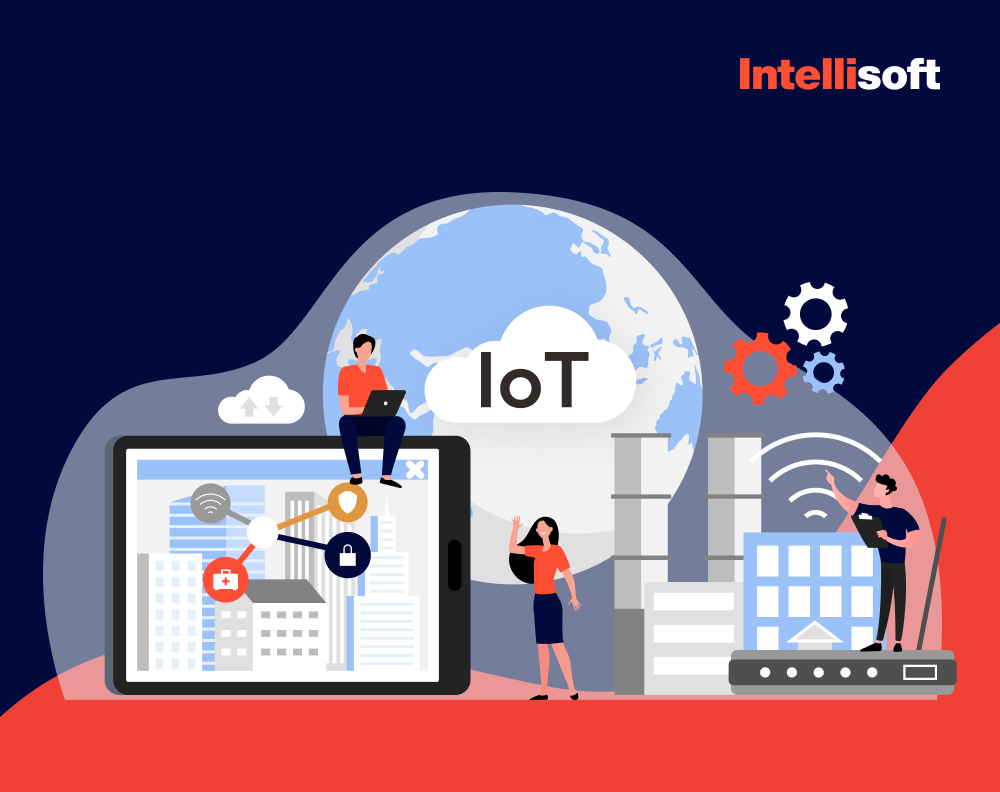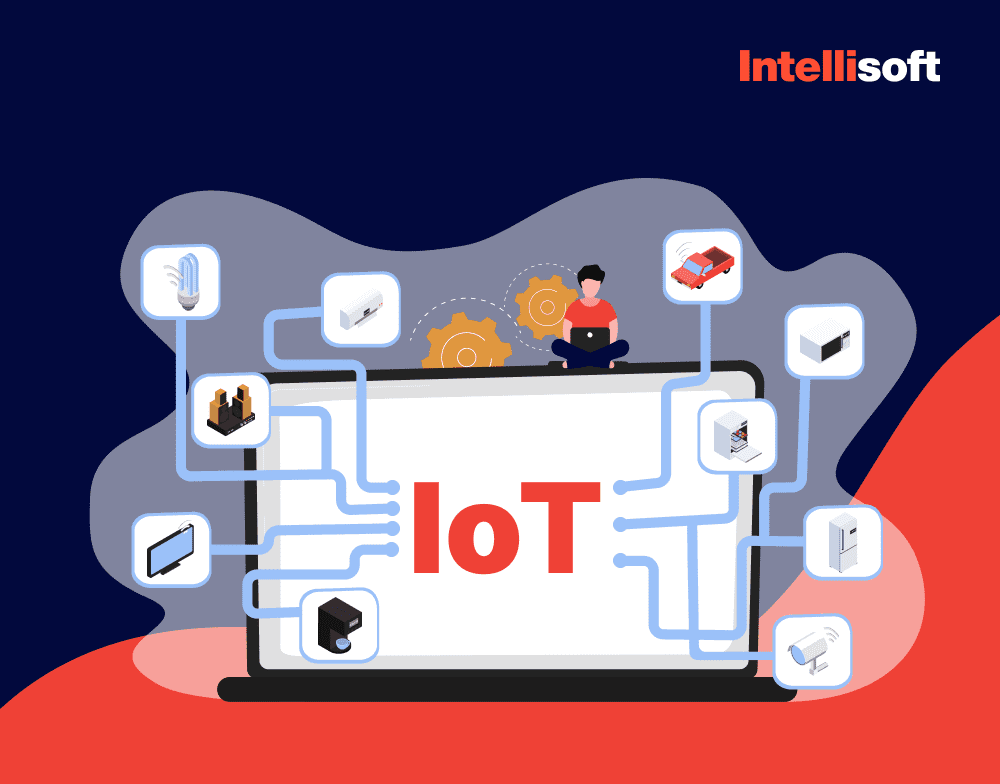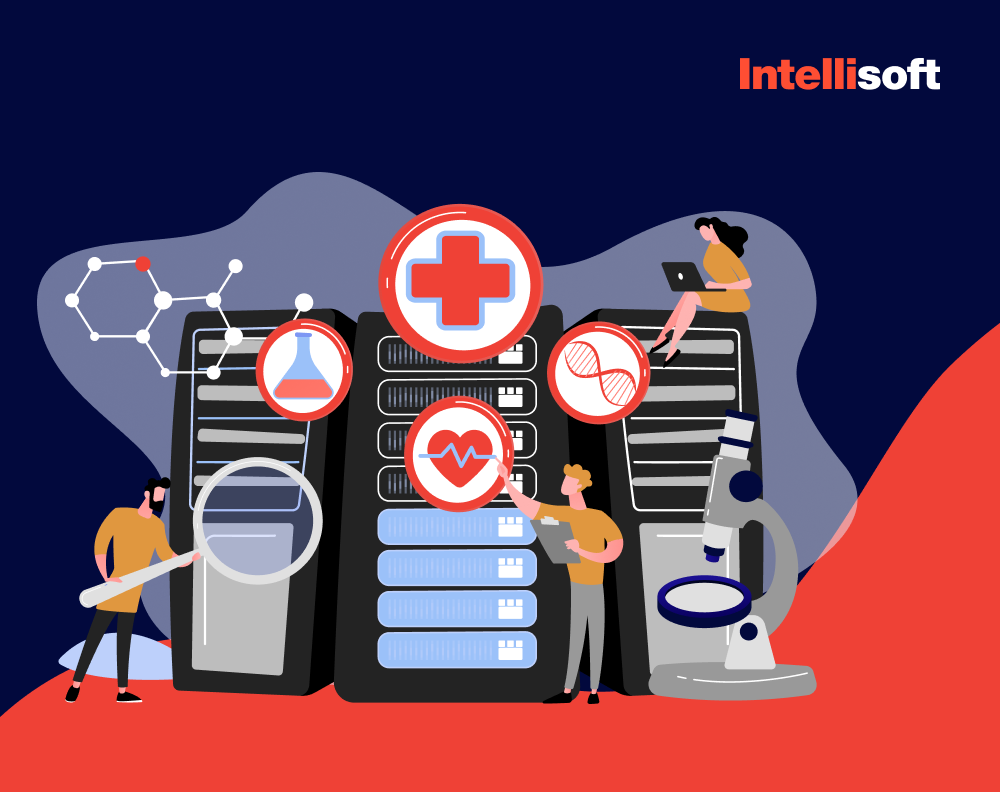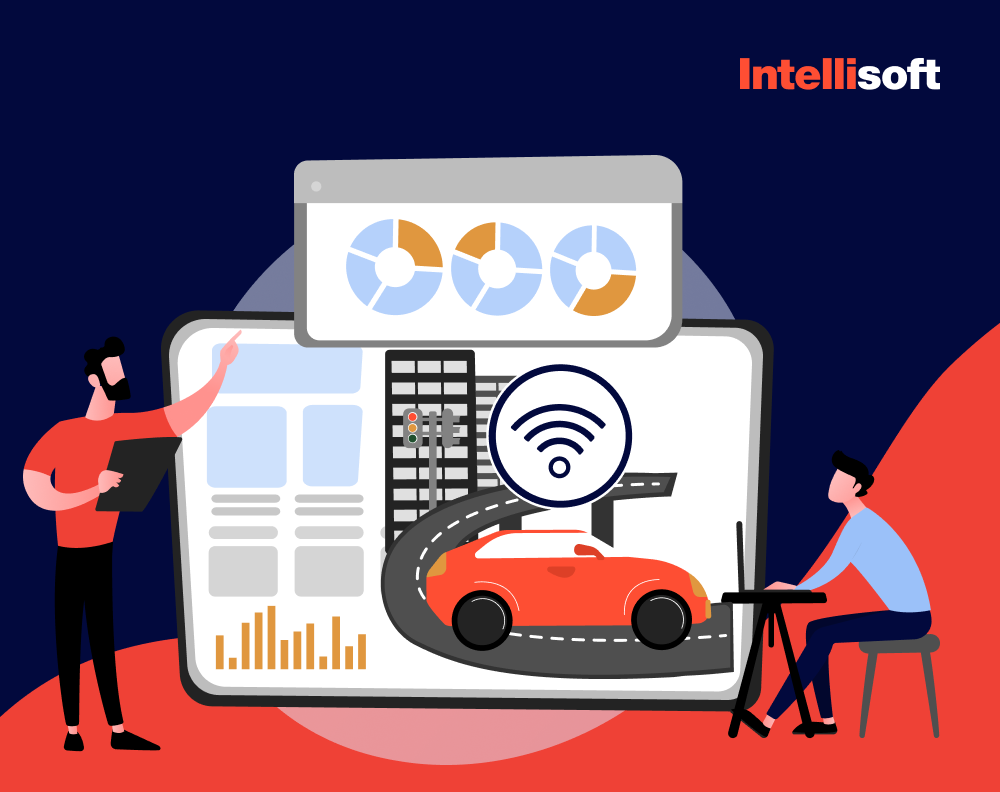The success of any business, especially in the industrial and manufacturing field, largely depends on how efficient its operations are. Every second your equipment is down translates directly into lost revenue. Businesses everywhere are searching for strategies that keep their costly machinery in top condition. This is where predictive maintenance IoT solutions come into play. This innovative approach to maintenance doesn’t just predict equipment failures before they happen – it significantly cuts down on unexpected downtime and upkeep expenses.
At IntelliSoft, we develop custom IoT software solutions to meet the manufacturing industry’s distinct challenges. Our expertise in integrating IoT devices through advanced protocols like OPC UA has empowered leading companies, including a prominent Swiss Industrial Equipment Manufacturer, to monitor their real-time vital data. This capability has revolutionized how they manage their assets.
We’re excited to share the knowledge and insights from real-world implementations in this article. We’ll walk you through the critical aspects of IoT based predictive maintenance and demonstrate how it can protect your investments while boosting operational efficiency.
Table of Contents
What is Predictive Maintenance?
Predictive upkeep quickly gained popularity as a forward-thinking approach to improving the efficiency of industrial operations. Unlike traditional methods that deal with failures as they occur, predictive maintenance (PdM) anticipates and addresses potential issues before they disrupt operations. It employs industrial IoT wireless predictive maintenance sensor data analysis tools to examine equipment conditions, using historical and real-time data to recommend proactive upkeep actions and enhancements.
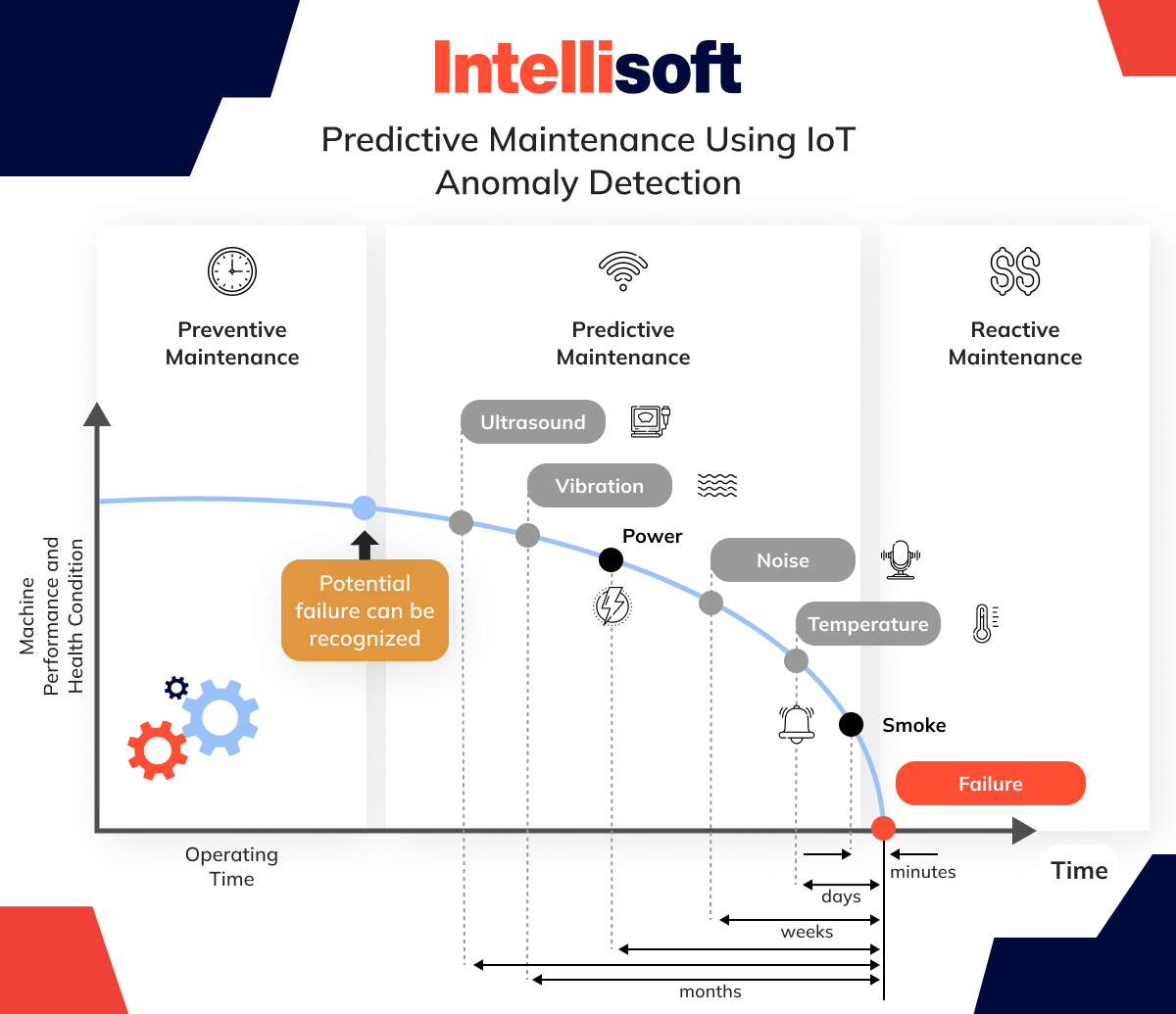
Exploring IoT-Enabled Preventative Maintenance
Consider what happens when maintenance teams wait for a machine to fail before they act. This reactive approach leads to prolonged downtime and inefficient resource use as teams rush to identify problems, source replacement parts, and make repairs.
Time-Based Preventative Maintenance
A more proactive model, time-based preventative upkeep, involves regular inspections and servicing of equipment regardless of its current state. Scheduled tune-ups aim to identify and resolve issues before they worsen, ideally prolonging equipment life and reducing sudden breakdowns. However, this method can lead to unnecessary maintenance or overlook problems that arise between checks.
Usage-Based Preventative Maintenance
This method schedules maintenance based on operational milestones, such as hours or cycles of use. It focuses on keeping systems efficient but can suffer from the drawbacks of any planned upkeep, which sometimes leads to premature or needless servicing.
Condition-Based Preventative Maintenance
This type of upkeep is where IoT technology starts to make a significant impact. Condition-based maintenance utilizes IoT-enabled sensors to monitor equipment’s state and performance continuously. This approach boosts efficiency and minimizes unplanned downtime by only performing upkeep actions when specific conditions are detected.
Predictive Maintenance
The IoT maintenance predictive approach refines the condition-based approach by integrating advanced analytics, machine learning, and AI to analyze sensor data. This infrastructure predicts potential failures, enabling strategically minimalistic maintenance. It aims to be as timely and efficient as possible, preventing issues before they occur and optimizing the use of resources.
The Role of Predictive Maintenance Industrial IoT
IoT technology is crucial for making predictive maintenance a practical tool. IoT platforms gather vast amounts of data in real time by incorporating predictive maintenance IoT sensors and intelligent devices into industrial equipment. This data is sent to cloud-based systems, where it is analysed using sophisticated machine-learning algorithms.
IoT enhances these capabilities in settings where supervisory control and data acquisition (SCADA) systems monitor operations, enabling broader and more intelligent data analysis. While SCADA systems manage local control and data acquisition, IoT extends this to include comprehensive cloud-based predictive maintenance IoT analytics, enriching the data with AI-driven insights.
The outcome is a proactive, intelligent upkeep strategy that forecasts and prevents failures, ensuring that manufacturing operations remain highly efficient with minimal disruptions. This approach is why increasing numbers of organizations in different industries rely on outsourcing companies like IntelliSoft to integrate IoT solutions into their maintenance protocols.
Benefits of IoT-based Predictive Maintenance
Unexpected equipment downtime during industrial operations represents a significant obstacle to achieving optimal productivity and ensuring safety. Integrating predictive maintenance and IoT is a groundbreaking solution, transforming potential crises into controlled, predictable scenarios. This dynamic duo is revolutionizing how companies manage their field equipment, aiming to enhance utilization, prolong equipment service life, and reduce the hazards associated with unscheduled downtimes.
Preventing Breakdowns and Downtime
IoT sensors vigilantly monitor equipment around the clock, identifying anomalies and deviations from standard operations. These sensors trigger immediate alerts, enabling support teams to respond swiftly, often before a potential failure becomes a real problem. This proactive stance significantly diminishes the likelihood of unexpected downtimes, marking one of the key benefits of predictive maintenance with IoT.
Enhancing Workplace Safety
The stakes of equipment malfunctions extend beyond financial losses – they pose real risks to worker safety and facility integrity. Systems using IoT in predictive maintenance excel at detecting early signs of potential failures. Organizations safeguard their assets and foster safer work environments by addressing these warnings without delay. This proactive measure helps prevent accidents and ensures health and safety regulations adherence.
Increasing Equipment Lifespan
IoT and predictive maintenance technology make consistent and precise upkeep possible, ensuring that machinery operates within optimal parameters. By maintaining equipment in top condition and addressing issues proactively, predictive upkeep strategies significantly extend the life of essential machinery. This approach goes beyond mere repairs, focusing on sustaining the efficiency and reliability of operational assets.
Reducing Maintenance Costs
The real-time data collected and analyzed by IoT devices enables companies to pinpoint and tackle the root causes of equipment problems early. Addressing issues before they escalate not only prevents major repairs but also minimizes wear and tear and reduces the frequency and intensity of maintenance needed. This strategy ultimately translates into significant cost reductions in upkeep budgets over time.
Boosting Production Efficiency
With IoT and predictive maintenance support, production processes are less likely to be disrupted by equipment failures. Maintenance schedules can be aligned with planned downtimes, minimizing their impact on production. This alignment ensures production lines operate more smoothly and efficiently, maintaining high productivity levels without the usual drawbacks of downtime, safety issues, or escalated costs.
By employing IoT for predictive maintenance, businesses protect their operational continuity and strengthen their competitive position in the market. This combination is a transformative asset that provides substantial, enduring advantages.
How Does Industrial IoT Predictive Maintenance Work?
The chart below illustrates a simplified view of the data management workflow essential for an IoT predictive maintenance software system. Let’s explore how we can optimize maintenance using IoT sensors, connectivity, and data analytics.
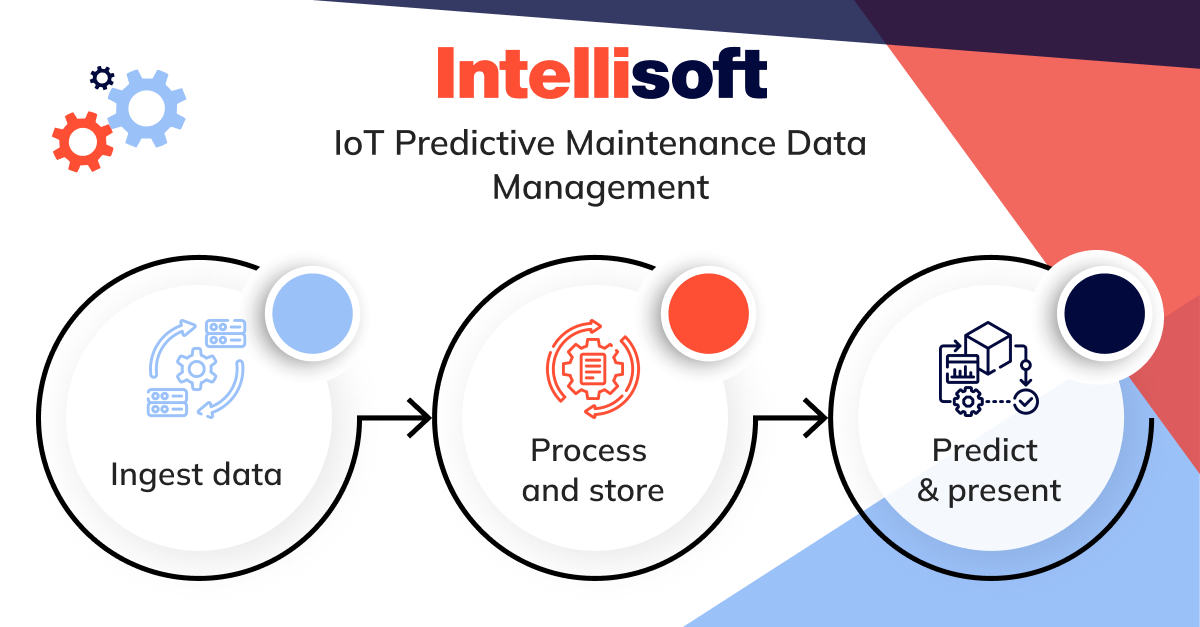
Ingest Data
Data collection is paramount at the outset of industrial IoT predictive maintenance. This process involves gathering information from various sensors installed on industrial equipment. These sensors track multiple parameters, such as temperature, vibration, and pressure. Being the primary IoT components, these sensors supply real-time data crucial for the subsequent stages of analysis and prediction. The quality and detail of the data collected are critical as they lay the groundwork for making precise predictions and analyses.
Process and Store
Following data collection, the information is transmitted, often in real time, to a processing location, which could be situated on-premises or, increasingly, in the cloud. This phase includes cleansing, normalizing, and aggregating the data to ready it for thorough analysis. After processing, the data is stored in a structured format in databases or data lakes, making it readily available for deeper analysis. Efficient processing and storage are crucial for managing the vast amounts of data generated by IoT devices, ensuring swift data retrieval and analysis.
Predict & Present
The final step involves sophisticated analysis using advanced analytics, IoT predictive maintenance machine learning algorithms, and occasionally artificial intelligence. This analysis processes the stored data to identify trends, detect anomalies, and predict potential equipment failures before they occur. Predictive insights can indicate when a machine part might fail or when service should be scheduled. These insights are then presented to end-users through interfaces like dashboards or reports. This information enables service teams to proactively schedule maintenance tasks, helping to prevent unforeseen downtime and prolong the operational life of equipment by ensuring that parts are serviced or replaced only when needed rather than on a rigid schedule.
IoT-Based Predictive Maintenance Architecture
The architecture of a predictive maintenance system based on IoT resembles a well-oiled machine—a complex yet precisely calibrated setup that depends on the smooth interaction of several critical elements. This system is engineered to transform raw data into actionable insights, significantly boosting operational efficiency and reliability.
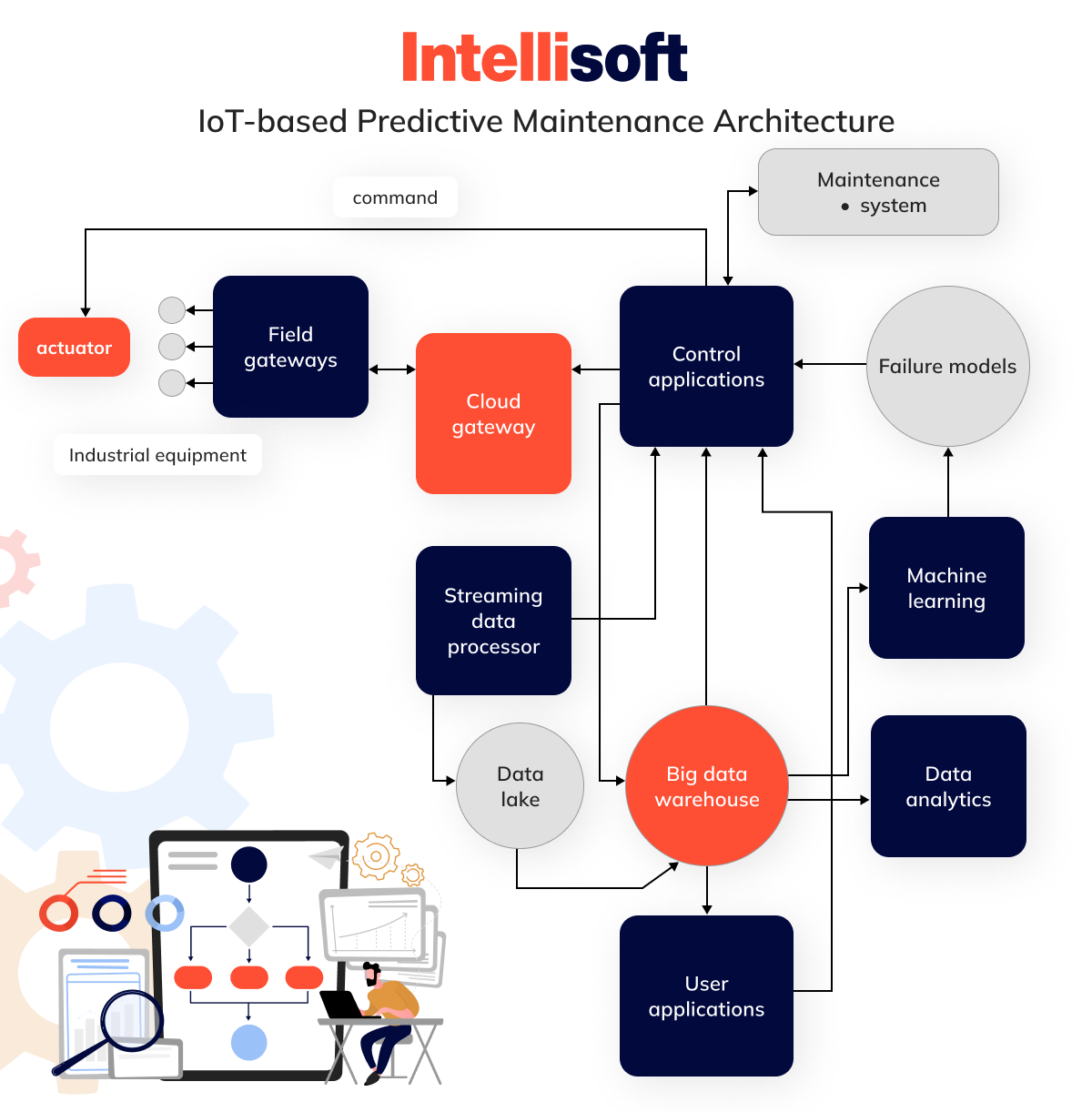
Key Components of IoT-based Predictive Maintenance
Sensors
Often overlooked, yet vital, sensors are the foundational elements of predictive maintenance. Positioned strategically on equipment, they monitor essential indicators such as temperature, vibration, and pressure. These sensors are crucial as they collect and relay the machinery’s health data to the system’s central analysis unit.
IoT Gateways
These gateways are essential conduits between the sensors embedded in industrial settings and the broader cloud environment. They efficiently transfer the collected data, filtering and preprocessing it to ensure that only pertinent information is sent to the cloud for detailed analysis.
Cloud Infrastructure for Data Storage
Picture an enormous digital library in the cloud that stores not books but vast quantities of data. This cloud infrastructure is a centralized repository, securely housing sensor data and other critical business information for subsequent retrieval and analysis.
Predictive Maintenance Platform
This platform is the system’s central nervous system. It manages the data flow, alerts stakeholders to deviations in equipment performance, and generates detailed reports that guide strategic decision-making and fine-tuning operations.
Data Processing and Analysis
At this stage, the raw data is converted into meaningful insights. Advanced algorithms analyze the sensor data to identify patterns and detect anomalies that may indicate potential equipment issues or predict future failures.
Predictive Models
Here, the system gains predictive power. Using the processed data, these models forecast potential problems and suggest optimal maintenance times, functioning almost like a crystal ball based on data-driven insights rather than mysticism.
User Applications
The final step involves channeling the insights and predictions into user-friendly applications. These dashboards provide real-time updates, alerts, and comprehensive reports, equipping service personnel with the necessary information to prevent failures and ensure seamless operations.
The design of an IoT-based predictive maintenance system is all about avoiding failures, enhancing operational efficiency, improving safety, and extending the lifespan of assets. It represents a shift towards more intelligent, predictive, and effective upkeep practices.
Related readings:
- IoT Connectivity: A Comparison Guide
- IoT Data Integration with Existing Systems: Bridging the Gap to Legacy Infrastructure
- How To Control IoT Devices To Reach Your Business Goals
- IoT in Oil and Gas Industry: Future of Energy Technologies
- Testing IoT Devices: Why and How to Examine the Internet of Things
Predictive Maintenance by Industries
The revolutionary impact of IoT-based predictive maintenance spans various sectors, each leveraging these advanced tools to address unique operational challenges. Here’s a closer look at some IoT predictive maintenance examples and how this technology transforms industries from discrete and process manufacturing to oil and gas, electric power, and railways.
Discrete Manufacturing
In discrete manufacturing, ensuring the integrity of machine components such as milling machine spindles is crucial. These breakdowns can be costly and disruptive. By incorporating IoT with ultrasonic sensors and conducting vibration analysis for IoT enabled predictive maintenance, manufacturers can predict the lifespan of these components. Analyzing sensor data helps anticipate failures, allowing for timely maintenance that avoids expensive disruptions. This proactive approach using IoT predictive maintenance for industrial ovens has cut diagnostic times by up to 70% and reduced repair times by over 20%, markedly enhancing overall equipment effectiveness (OEE).
Process Manufacturing
Industries within process manufacturing, including pulp and paper to steel production, find a strong ally in industrial IoT predictive maintenance. Equipping machinery such as paper-making machines with temperature and vibration sensors enables forecasts of failures in essential components such as bearings and gears. In steel production, detecting leaks in furnace cooling panels is critical. Early identification through IoT solutions prevents safety risks and production delays, safeguarding equipment from damage.
Oil and Gas
In the high-stakes oil and gas sector, where inspections often occur under hazardous conditions, IoT predictive maintenance provides a safer alternative. Sensors monitor for corrosion, pipeline damage, and other potential failures, with real-time data processed in the cloud, allowing for quick preventive actions. This approach has resulted in a 30% reduction in service costs, 70% fewer breakdowns, and a 40% decrease in downtime.
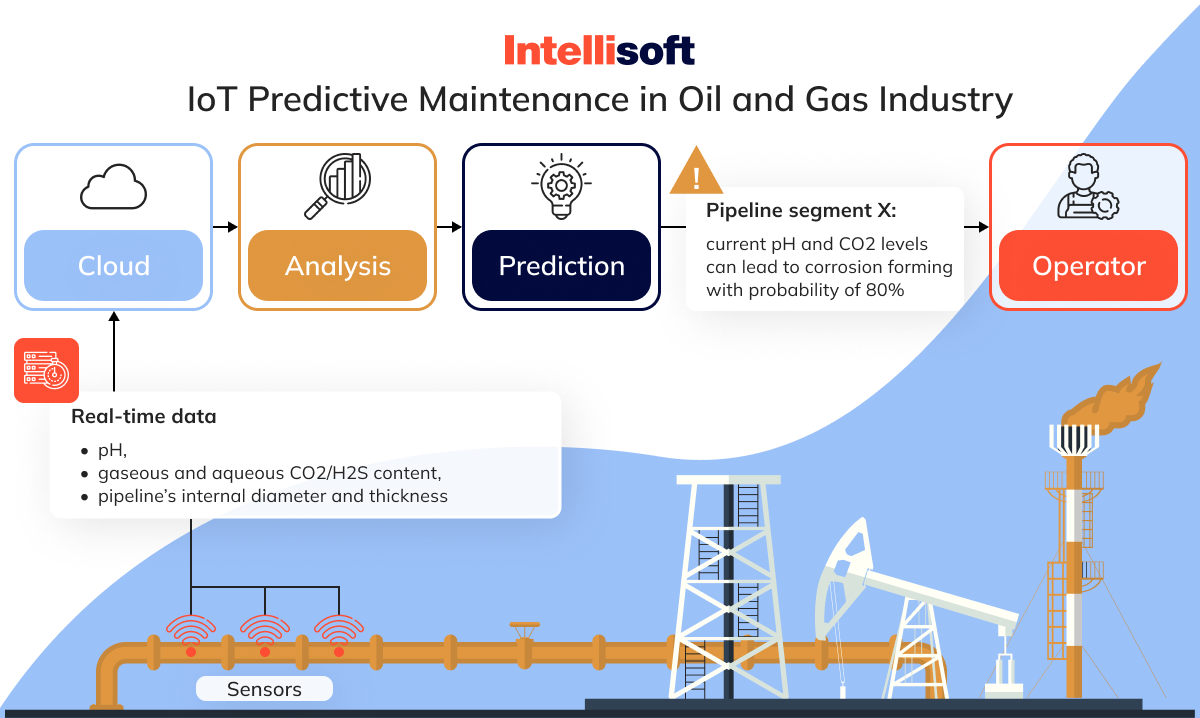
Electric Power Industry
In the electric power industry, reliability is critical, especially during peak demand. IoT-based maintenance systems with vibration sensors continuously monitor turbine health. Data analyzed via machine learning algorithms enables power plants to address issues preemptively, maintaining a consistent power supply. This predictive maintenance IoT use case helps identify inefficient turbine operations or foresee potential failures, preventing costly outages.
Railways
Railway companies have adopted this upkeep approach, employing smart sensors for IoT predictive maintenance, such as force detectors, vision cameras, and infrared and acoustic sensors on tracks and rolling stock. These devices help detect issues from braking system defects to wheel friction. Machine learning analysis of this data allows railways to proactively address upkeep needs, improving safety, reliability, and operational efficiency while reducing delays caused by equipment malfunctions.
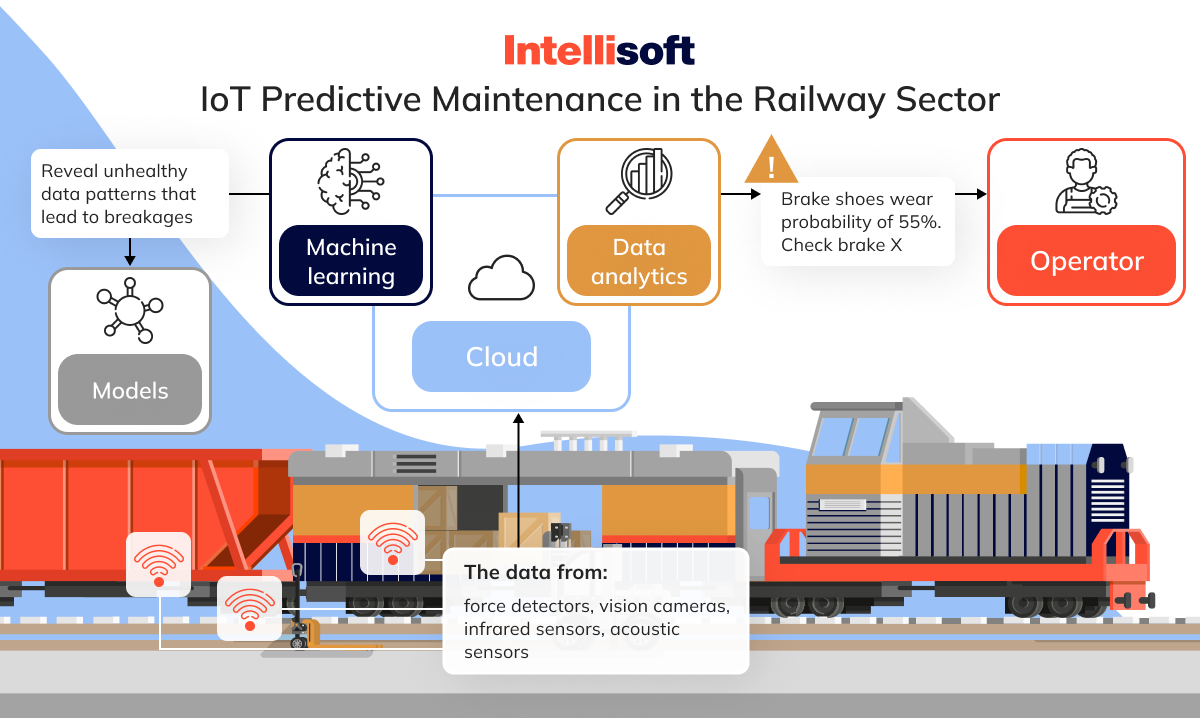
Across these diverse sectors, each IoT predictive maintenance case study shows that this technology is proving to be a game-changer, enhancing operational efficiency, safety, and sustainability. By integrating IoT with predictive maintenance strategies, companies avoid potential crises and optimize their maintenance routines.
Top IoT Sensors for Predictive Maintenance
In the complex choreography of predictive maintenance, sensors are tireless performers, continuously providing crucial data that drives servicing decisions. These sensors are foundational to IoT systems, each playing a pivotal role in ensuring machinery operates smoothly and efficiently.
Pressure Sensors
Subtle changes in pressure can indicate problems like leaks or blockages in systems handling fluids and gases. Pressure sensors act as vigilant monitors in pipelines and tanks, alerting to any changes that might indicate issues, which is crucial in industries such as water treatment and oil and gas.
Gas Sensors
The air in industrial settings might contain invisible dangers. Gas sensors detect hazardous gases before they become a safety threat. Commonly used in the oil and gas sector, these predictive maintenance smart sensors for IoT are vital for monitoring indoor air quality in residential and commercial spaces.
Temperature Sensors
Equipment overheating can often lead to failure. Temperature sensors monitor the thermal signatures of critical machinery, providing early warnings to prevent damage due to excessive heat. They are used in various sectors, including agriculture and manufacturing, and protect equipment, processes, and products.
Humidity Sensors
In electronics manufacturing, where moisture can cause significant damage, humidity sensors track air moisture levels. Essential for maintaining dry conditions, these sensors are also integral to HVAC systems, ensuring optimal humidity to protect environments and processes.
Vibration Sensors
Even minor vibrations can signal potential issues in heavy machinery. Vibration sensors detect these abnormal tremors, alerting service teams to possible problems. Industries that operate heavy-duty machinery, such as motors and compressors, rely heavily on these sensors for early warning signs. If you need a guide to choose iot vibration sensors for predictive maintenance, you can always contact our specialists.
Current Sensors
Though electricity is invisible, current sensors make its effects observable by tracking electrical currents. They identify irregularities that could predict electrical equipment failures, providing essential predictive insights to service teams.
Proximity Sensors
Proximity sensors utilize electromagnetic fields to detect the presence of objects without physical contact. They are widely used in retail settings to enhance customer experiences and in industrial environments to monitor the positioning of machine parts for optimal safety and efficiency.
Security Sensors
Maintaining secure operations involves preventing intrusions so that operations can proceed without disruptions. Security sensors include a variety of devices such as motion detectors, GPS trackers, and infrared sensors, safeguarding both physical and operational environments.
Together, these sensors create a network of intelligence, a sophisticated web of awareness essential for effective predictive maintenance. They act as IoT systems’ eyes, ears, and nerves, tirelessly collecting data to keep industries running smoothly, safely, and without interruption.
Top Challenges of Implementing IoT Predictive Maintenance Solutions
The efforts spent to successfully implement IoT-based predictive maintenance hold immense potential but also present significant challenges. Businesses must effectively address these obstacles to fully leverage this technology’s advantages.
Data Overload
In today’s era of big data, the challenge of ‘too much information’ is more relevant than ever. IoT devices generate enormous amounts of information, which can overwhelm traditional data processing systems. This flood of data can obscure the analysis process, making it difficult to extract actionable insights from a vast data pool.
Partnering with a vendor skilled in data management and IoT analytics predictive maintenance is essential. Such a partnership can help filter the data, identify significant patterns, and provide advanced data processing tools to aid decision-making.
IoT Integration with the Existing System
Integrating new IoT systems with older legacy infrastructures is like merging two different cultures. This integration must be handled carefully to ensure smooth operation and maintain security. An inadequately secured IoT setup can expose the network to cyber threats, putting the entire system at risk.
Working with a vendor that emphasizes security and has solid security protocols in place is crucial. The integration should include secure network protocols, end-to-end encryption, and security certificates to strengthen the IoT ecosystem against potential cyber threats.
Difficulty in Implementing Predictive Maintenance Using IoT
Transitioning from the conceptual phase to executing predictive maintenance using IoT can be challenging. Companies might face obstacles such as lacking in-house technical expertise, data portability difficulties, and risks linked to adopting a new system. These issues can cause delays, extend timelines, and result in an ROI that doesn’t immediately meet expectations.
Choosing a vendor that offers a thorough discovery phase is vital. This step should define the project’s baseline, identify possible risks, and align the business objectives with user needs, ensuring a strategic approach to integrating IoT predictive maintenance.
IntelliSoft is prepared to help you overcome these challenges. With our extensive experience in IoT and a comprehensive range of services, we are ready to customize IoT predictive maintenance solutions that meet your industry-specific needs. Our dedicated teams, backed by proven collaboration models, are committed to providing the expertise and support needed to enhance your upkeep strategies through the power of IoT.
Conclusion
We live in the exciting Fourth Industrial Revolution, and predictive maintenance emerges as a guiding light, leading businesses toward the peak of operational efficiency. This technological shift is not merely about preventing failures – it starts a new era of unparalleled efficiency, where each data point drives us closer to flawless uptime.
Envision a world where analytics don’t just alert us but act as the rhythmic drumbeats to a masterfully orchestrated plan. Here, maintenance teams become the conductors of an uninterrupted operational symphony, transforming scheduled downtimes into strategic pauses that save time and resources.
However, predictive maintenance is only a partial remedy. It’s a sophisticated instrument that, when expertly applied, can unleash savings and streamline operations across various platforms. Sometimes, the traditional touch of preventive and reactive maintenance might still be necessary. The future belongs to those adept at deploying this technology where it yields the greatest benefit.
Our expertise in IoT systems and predictive maintenance allows us to adopt new technologies and strategically align these innovations with your business objectives. If you’re ready to embrace this transformative shift and revolutionize your upkeep strategies, IntelliSoft is prepared to become your trusted partner of choice. Armed with advanced tools and insights, our expert teams are here to ensure that your operations sprint forward.
Are you curious to see how predictive maintenance can revolutionize your business? Are you keen to explore your industry’s IoT-enabled future? Connect with IntelliSoft today, and let’s begin our journey together.


